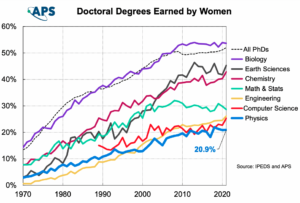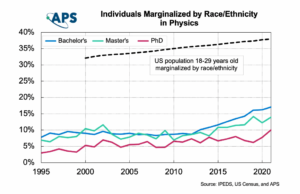According to the American Physical Society (APS), today only 21% of physics PhDs are awarded to women. The fields of engineering, computer science, mathematics and statistics fare only slightly better. The numbers look even more disappointing for underrepresented minorities, who account for only 10% of physics PhDs.


This is an issue that Lab researchers are rolling up their sleeves to try to address, working with the American Physical Society.
Hendrik Ohldag, a staff scientist at the Advanced Light Source, and Lipi Gupta, a science engagement engineer at the National Energy Research Scientific Computing Center (NERSC), are engaged in these efforts to improve diversity in the field of physics. Hendrik is co-chair of Berkeley Lab’s American Physical Society IDEA group, which is part of APS’ Inclusion, Diversity, and Equity Alliance (APS-IDEA), along with ALS’ Gregory Su. Lipi is the LBNL co-chair for the 2025 CU*IP, a conference for undergraduate women in physics.


L to R: Lipi Gupta, Hendrik Ohldag
Said Hendrik, “The Lab and society can’t afford to miss out on talent. We know that in K-12, there are lots of talented STEM students who don’t find their way into STEM careers. We need to support the STEM efforts in schools by being more actively involved and showing kids of all backgrounds that a career in STEM is possible for them.”
Berkeley Lab’s APS IDEA Group
When the American Physical Society started its IDEA group during the pandemic and reached out to the physical sciences community across 100 institutions, including Berkeley Lab, Hendrik quickly got engaged. “There are lots of people in the field with good intentions, but they are not trained to approach problems in social science. The APS IDEA network provides training and sharing of best practices. For example, we learned about the theory of change, which uses a “logic model” to effect change in social structures; this helped us think about what steps are needed to advance equity, diversity, and inclusion.”
“Our long-term goal is to change the culture at the national labs so that it is more equitable,” Hendrik continued.
CU*IP: Helping Undergraduate Women in Physics Feel at Home
In addition to the APS IDEA effort, the Lab is also working with UC Berkeley to host APS’ Northern California Conference for Undergraduate Women and Gender Minorities in Physics (CU*IP) in 2025, formerly the Conference for Undergraduate Women in Physics (CUWIP). Hendrik and Lipi are members of the Northern California CU*IP consortium, which is a group that consists of Stanford, UC Berkeley, UC Davis, UC Santa Cruz, and UC Merced, which rotate hosting the two-day conference. Other CU*IP regions host conferences throughout the country, totaling about 25 conferences and engaging more than 2,000 women undergraduates interested in physics.
Lipi is the LBNL co-chair for the 2025 CU*IP, which will be hosted jointly by Berkeley Lab and UC Berkeley.
“I was excited to take on the role of co-chair,” said Lipi. “I had attended CUWIP as an undergraduate at Cornell. It was the first conference I had ever attended, and I learned what conferences were all about – learning about new things in the field, meeting people, and feeling like I was part of the physics community. That feeling of belonging was very important; at Cornell, I had very few female professors and almost all were in my non-science courses. Seeing all the women physicists at CUWIP was an eye-opener and made me feel like I could be a part of this community.”
In addition, because the conference was co-hosted by Brookhaven National Lab and Stony Brook University, Lipi learned about the national lab system and toured Brookhaven’s facilities, including its accelerator, which was relevant to Lipi’s area of study.
According to Lipi, the CU*IP conference is a good way to get the word out to young physicists about the opportunities at a national lab. “Many academic positions don’t pay well and tenure is difficult to get, so women and minority physicists are not encouraged to stay in the field. National labs have more opportunities and offer equitable pay and good benefits. I want to spread the word to women scientists and scientists of color that they can have a great career at a national lab,” said Lipi.
Encouraging Women and Minority Scientists
Lipi and Hendrik think that the Lab community can do a lot to encourage and support young women and minority scientists at the Lab, from interns to postdocs to early-career scientists.
“Many of these young researchers are the first in their families to be in this field, so they might not know if they are doing the right thing, or they may be struggling with impostor syndrome. It can help to hear that they are doing well, or to get guidance or help if they need it. It’s not enough to expect them to ‘just figure it out.’”
Hendrik adds, “At Berkeley Lab, we are lucky to have a culture in which inclusiveness is valued. It’s not always the case elsewhere. If you are in a particular situation and notice that the environment is not supportive, think about what you can do to make a difference. Lab employees can bring this mindset to all their interactions, whether at the Lab or beyond.”

